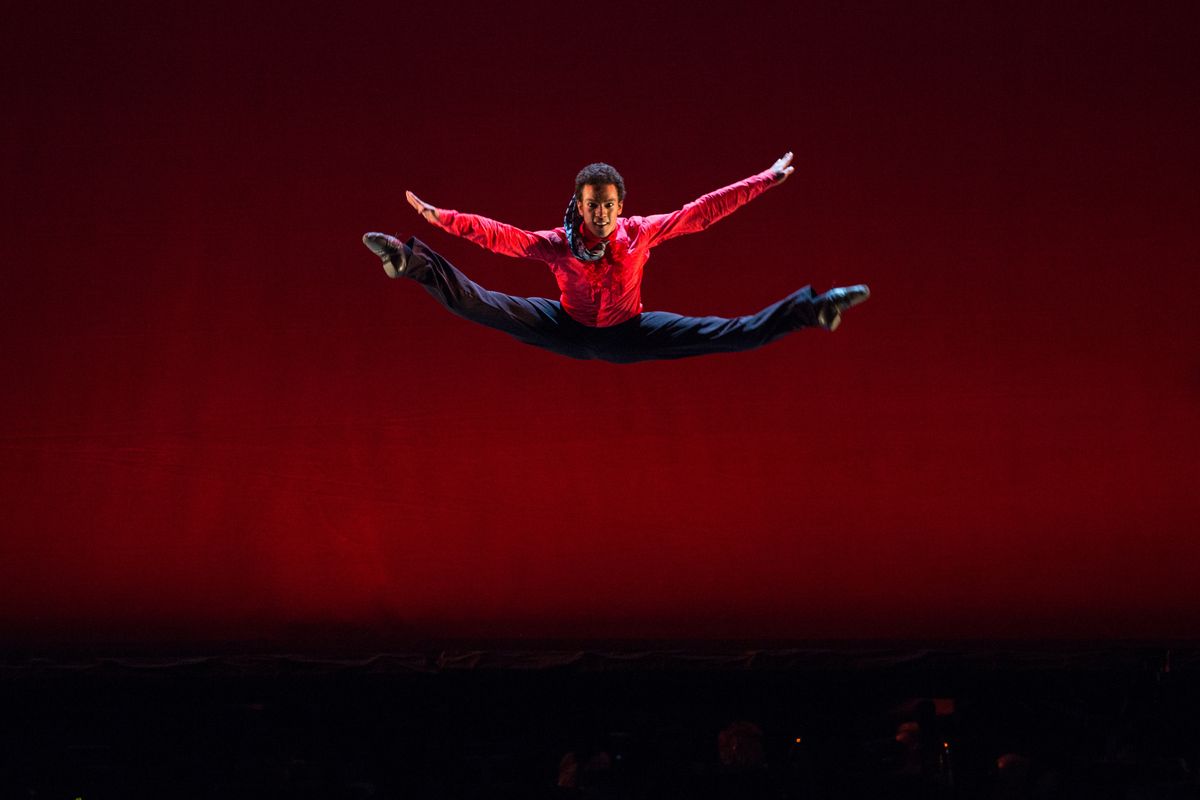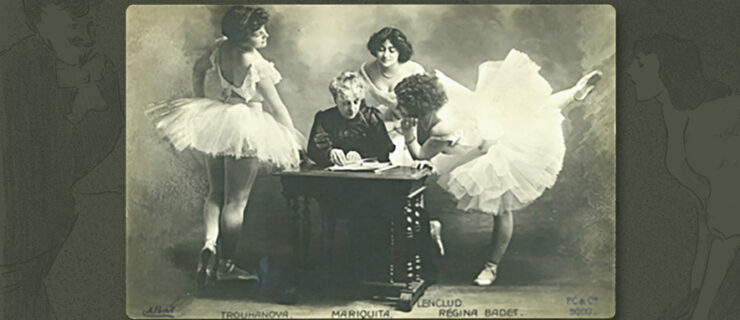2014 Stars of the Corps: Seven of Ballets Next Breakout Stars
This story originally appeared in the August/September 2014 issue of
Pointe.
In every corps de ballet there are certain dancers who shine. Here are seven with bright futures ahead.
Amanda Assucena, Joffrey Ballet

Assucena in Krzystof Pastor’s Romeo & Juliet
Cheryl Mann, Courtesy Joffrey Ballet
Not many first-year company members get the chance to perform a principal role, let alone two—but last season, the Joffrey Ballet’s Amanda Assucena did just that. In addition to dancing the Sugar Plum Fairy in the company’s production of The Nutcracker, Assucena, then 19, was cast as the lead in Krzysztof Pastor’s Romeo & Juliet. “Dancing Juliet was something that I never expected my first year as a professional,” she says.
Trained in her native Brazil, Assucena moved to the U.S. and spent four years at The Harid Conservatory before joining the trainee program at the Joffrey Academy of Dance in Chicago. After just one year, she received a company contract. With out-of-this-world extensions, spot-on technique and a delicate softness to her movement, it’s easy to see why she’s getting noticed. But it’s her ability to embody characters honestly that sets her apart. With Joffrey’s wide-ranging rep, Assucena hopes to absorb as much as she can from her fellow company members.
Now that Juliet and Sugar Plum are under her belt, what does she hope for next? “One of my dream roles is Giselle,” she says. “After the Rain, Infra and Chroma are obsessions of mine, too.” —Margaret Hermanson
Nicole Padilla, Sarasota Ballet

Padilla in Frederick Ashton’s Birthday Offering
Gene Schiavone, Courtesy Sarasota Ballet
Before joining Sarasota Ballet, Nicole Padilla had barely heard of Frederick Ashton. But under directors Iain Webb and Margaret Barbieri—who have introduced a dozen of the British choreographer’s works to the repertoire—Padilla has become not only an Ashton aficionado, but an accomplished interpreter of his work. During the company’s recent Sir Frederick Ashton Festival, she triumphed in the peppy Elaine Fifield role in Birthday Offering, flawlessly executed the fouettés of the Blue Girl in Les Patineurs and showed off her range in both the polka solo and the “Scotch Rhapsody” in Façade.
The 26-year-old Texas native spent two years at the University of Oklahoma and another at the Joffrey Ballet School before joining Dayton Ballet. She came to Sarasota Ballet in 2011, but sat out most of her second season with a back injury. After recovering, she quickly made headway, dancing in the company’s performances of Les Patineurs at the Kennedy Center’s Ballet Across America festival last June (and drawing praise from several critics). “I’m more the athletic, jumping, turning type,” she admits. Her dream role? “Kitri from Don Q,” she says. “I’m just not a swan.”
Padilla, who married in June, also teaches at the Margaret Barbieri Conservatory of Dance, and is pursuing an elementary education degree at the University of South Florida. “How do I do it all?” she asks. “I have no idea.” —Carrie Seidman
Kathryn Hosier, National Ballet of Canada

National Ballet of Canada’s Kathryn Hosier
Sian Richards, Courtesy NBoC
Kathryn Hosier’s long legs, trousered in black, shimmer under a hyper-articulated torso as she executes the fast, angular, punctuated arm movements of Marco Goecke’s reimagined version of Le Spectre de la Rose. This is the same dancer who in pure classical mode can portray a Sleeping Beauty fairy or Swan Lake Spanish princess.
“What I love about the National Ballet is the sheer range of repertoire,” says 23-year-old Hosier, thrilled that Goecke plucked her from the corps to dance the female lead in the North American premiere of Spectre in May. “It was a huge technical challenge, but also a big career break.”
Born and initially trained in Champaign, Illinois, Hosier spent three finishing years at Canada’s National Ballet School. Hired into the company as an apprentice in 2009, she was taken into the corps within six months. While competition for roles is always intense, last year Hosier was center stage in No. 24, an ultra-physical duet choreographed by company member Guillaume Côté.
Hosier has no illusions about the waiting game that’s often a corps member’s lot. Still, landing an opening night lead has whetted her appetite. “Once you get a taste, you want more and more and more.” —Michael Crabb
Julia Rowe, San Francisco Ballet

Rowe (left) in Helgi Tomasson’s Giselle
Erik Tomasson, Courtesy SFB
There’s a breezy sweetness to Julia Rowe’s peasant pas de cinq variation in San Francisco Ballet’s Giselle. Nothing in the intricate steps looks calculated and yet, there’s a world of thoughtfulness behind the ease.
“So much of that variation for me is about finding nuances in the music and the phrasing,” she says. “But there’s also discovering more in what you can bring besides just steps. In order for Giselle’s descent into madness to be heartbreaking, there has to be an overwhelming sense of joy beforehand.”
A native of Elizabethtown, Pennsylvania, Rowe trained for 11 years at Central Pennsylvania Youth Ballet. In 2005, she attended SFB’s summer program because it was the home of one of her idols, Tina LeBlanc, and by 2007 had enrolled in the school year-round. Afterwards she joined Oregon Ballet Theatre, where she was nominated for a Princess Grace Award in 2010. Five years later, however, she came back to SFB, attracted by the diverse repertoire and the artists with whom she’d get to work.
Since then she’s charmed audiences with her fluid musicality and graceful épaulement, moving easily between the classicism of Giselle, the precision of Mark Morris’ Maelstrom and the dazzle of Liam Scarlett’s Hummingbird.
“It’s intimidating, exciting and incredibly artistically fulfilling for me to be in this kind of environment,” she says. “There’s always something new and challenging.” —Mary Ellen Hunt
Emily Bowen, Houston Ballet

Bowen and artists of Houston Ballet in Stanton Welch’s The Ladies
Amitava Sarkar, Courtesy Houston Ballet
Watching Houston Ballet’s petite Emily Bowen barrel downstage in a whirl of pirouettes, it’s no wonder that artistic director Stanton Welch selected her as the “flute” for his recent The Young Person’s Guide to the Orchestra. She excels at Welch’s flair for flash, but never loses her razor-sharp punctuation. “Stanton tends to cast me in roles that test my ability to move lightning fast and be technically precise—all while covering large amounts of space,” says Bowen.
Bowen trained under Patricia McBride and Jean-Pierre Bonnefoux at the North Carolina Dance Theatre School of Dance and at Houston Ballet Academy, where she competed in the Prix de Lausanne before joining the company in 2006.
A skilled chameleon, she can transition between a vintage, china-doll ballerina excelling in old-school delicacy one minute and a pocket-sized ball of fire in William Forsythe’s The Vertiginous Thrill of Exactitude the next. Her extensive rep includes lead roles such as Lise in La Fille mal gardée and the pas de deux in “Rubies.”
Next season, Bowen looks forward to reprising Edwaard Liang’s Murmuration. “I was a part of the world premiere last season, and the response was so overwhelming,” she says. “It holds a very special place in my heart.” —Nancy Wozny
Meaghan Dutton-O’Hara, New York City Ballet

Dutton-O’Hara in Peter Martins’ Jeu de Cartes
Paul Kolnik, Courtesy NYCB
It’s not often that a corps member nabs your attention when there are principals onstage at New York City Ballet. But Meaghan Dutton-O’Hara has been stealing the spotlight since she joined the company as an apprentice in 2011. Last season, she maneuvered effortlessly through George Balanchine’s Raymonda Variations, crisply elegant despite her long limbs. Even standing in a row of dancers framing the stage, a simple gesture of her arm can be arresting—as if the music plays from her port de bras.
Raised in Maryland, 20-year-old Dutton-O’Hara trained at the Frederick School of Classical Ballet. A summer intensive at the School of American Ballet in 2007 led to her staying on year-round. “NYCB had always been my dream,” she says.
Since joining the company, Dutton-O’Hara has been pursuing an undergraduate degree at nearby Fordham University, taking classes in the morning before company class. (She wants to major in either math or economics.) “I knew if I took a break from my education, I wouldn’t go back,” she says.
Dutton-O’Hara’s main focus, though, remains dancing, hoping to someday perform the leads in Serenade and Symphony in Three Movements. She’s already begun to show the subtlety of phrasing that sets dancers apart in NYCB’s repertoire. Her secret? “Remember to dance for you. I think that’s most rewarding for the audience, as well.” —Shannon Woods
Irlan Silva, Boston Ballet

Silva in Boston Ballet’s The Nutcracker
Gene Schiavone, Courtesy Boston Ballet
Watching Irlan Silva dance, you see a prince: jumps soaring with regal abandon, innate noble carriage, gorgeous feet and extensions. But what you won’t see is the poverty-stricken favela where the 24-year-old grew up in Rio de Janeiro, or the years of scholarships, training and ballet competitions that fueled his rise. “I’m always thinking about what I passed through to get here,” he says. “I have to keep pushing myself to be one of the best.”
At 10, Silva started out learning to tap. But his natural flexibility and coordination led to a jazz scholarship at the Centro de Dança Rio. When his teacher encouraged him to try classical ballet, he admitted he’d never seen it before. “We didn’t have access to theaters or culture,” he says, so she took him to see a performance. “I was so impressed. I thought, ‘Yes! I want to do that!’ ”
Hard training and competitions followed. At 17, he won Best Contemporary Dancer at Youth America Grand Prix. That same year, his performance at Prix de Lausanne led him to a contract with American Ballet Theatre II. There, his inspiring story was documented in the 2009 film Only When I Dance.
Silva joined Boston Ballet in 2011, attracted to its combination of classical and contemporary work. “I feel more free doing contemporary,” he says, although his goal is to excel at both. So far, he is excelling across the board; this spring, Silva danced his first principal role in Harald Lander’s Etudes.
When it comes to the future, Silva knows what he wants. “My dream is to be a principal dancer with Boston Ballet,” he says. If this past season is any measure, he is well on his way. —Ashley Rivers





